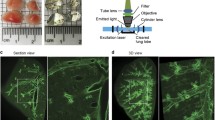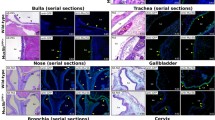Abstract
Staining by 5-bromo-4-chloro-3-indolyl-beta-D-galactopyranoside (X-gal) typically detects activity of E. coli β-galactosidase (β-gal) in transduced tissues that express the LacZ reporter gene. In lung tissue from mice that received β-galactosidase-expressing adeno-associated virus (AAV) vectors via intranasal inhalation, we observed only a low frequency of positive cells after X-gal staining in contrast to other reporter genes, such as alkaline phosphatase or green fluorescent protein. In this study, we systematically tested a number of parameters to improve the sensitivity of X-gal staining in lungs transduced with β-galactosidase-expressing AAV2/5 vectors. We observed that the use of nuclear-targeted LacZ instead of cytoplasmic LacZ as the reporter gene substantially increases the number of positive cells after X-gal staining. The pH of the staining solution determines staining sensitivity and background staining with pH 7.0 resulting in high sensitivity and no background levels. Glutaraldehyde at 0.2% or 0.5% in PBS as fixative provides optimal results for X-gal staining. The alternative substrate, Bluo-gal, showed no improvement compared with X-gal but instead caused nonspecific background staining. We further stained intact fixed lungs with X-gal and processed them for paraffin embedding or cryosectioning, resulting in equal staining intensities. However, en bloc staining of intact tissues resulted in the absence of positive cells within deeper-located lung areas.






Similar content being viewed by others
References
Anson DS, Limberis M (2004) An improved beta-galactosidase reporter gene. J Biotechnol 108:17–30
Auricchio A, O’Connor E, Weiner D, Gao GP, Hildinger M, Wang L, Calcedo R, Wilson JM (2002) Noninvasive gene transfer to the lung for systemic delivery of therapeutic proteins. J Clin Invest 110:499–504
Ave P, Colucci-Guyon E, Babinet C, Huerre MR (1997) An improved method to detect beta-galactosidase activity in transgenic mice: a post-staining procedure on paraffin embedded tissue sections. Transgenic Res 6:37–40
Blanks JC, Spee C, Barron E, Rich KA, Schmidt S (1997) Lineage study of degenerating photoreceptor cells in the rd mouse retina. Curr Eye Res 16:733–737
Bonnerot C, Rocancourt D, Briand P, Grimber G, Nicolas JF (1987) A beta-galactosidase hybrid protein targeted to nuclei as a marker for developmental studies. Proc Natl Acad Sci USA 84:6795–6799
Cheng G, Thompson RP, Gourdie RG (1999) Improved detection reliability of beta-galactosidase in histological preparations. Biotechniques 27:438–440
Coates PJ, Lorimore SA, Rigat BA, Lane DP, Wright EG (2001) Induction of endogenous beta-galactosidase by ionizing radiation complicates the analysis of p53-LacZ transgenic mice. Oncogene 20:7096–7097
Couffinhal T, Kearney M, Sullivan A, Silver M, Tsurumi Y, Isner JM (1997) Histochemical staining following LacZ gene transfer underestimates transfection efficiency. Hum Gene Ther 8:929–934
Croyle MA, Cheng X, Sandhu A, Wilson JM (2001) Development of novel formulations that enhance adenoviral-mediated gene expression in the lung in vitro and in vivo. Mol Ther 4:22–28
Gao GP, Alvira MR, Wang L, Calcedo R, Johnston J, Wilson JM (2002) Novel adeno-associated viruses from rhesus monkeys as vectors for human gene therapy. Proc Natl Acad Sci USA 99:11854–11859
Kawada T, Shin WS, Nakatsuru Y, Koizumi T, Sakamoto A, Nakajima T, Okai-Matsuo Y, Nakazawa M, Sato H, Ishikawa T, Toyo-Oka T (1999) Precise identification of gene products in hearts after in vivo gene transfection, using Sendai virus-coated proteoliposomes. Biochem Biophys Res Commun 259:408–413
Kobinger GP, Weiner DJ, Yu QC, Wilson JM (2001) Filovirus-pseudotyped lentiviral vector can efficiently and stably transduce airway epithelia in vivo. Nat Biotechnol 19:225–230
Lal B, Cahan MA, Couraud PO, Goldstein GW, Laterra J (1994) Development of endogenous beta-galactosidase and autofluorescence in rat brain microvessels: implications for cell tracking and gene transfer studies. J Histochem Cytochem 42:953–956
Loewy AD, Bridgman PC, Mettenleiter TC (1991) beta-Galactosidase expressing recombinant pseudorabies virus for light and electron microscopic study of transneuronally labeled CNS neurons. Brain Res 555:346–352
Ma W, Rogers K, Zbar B, Schmidt L (2002) Effects of different fixatives on beta-galactosidase activity. J Histochem Cytochem 50:1421–1424
Mahony D, Karunaratne S, Rothnagel JA (2002) Improved detection of lacZ reporter gene expression in transgenic epithelia by immunofluorescence microscopy. Exp Dermatol 11:153–158
Medina MF, Kobinger GP, Rux J, Gasmi M, Looney DJ, Bates P, Wilson JM (2003) Lentiviral vectors pseudotyped with minimal filovirus envelopes increased gene transfer in murine lung. Mol Ther 8:777–789
Rosenberg WS, Breakefield XO, DeAntonio C, Isacson O (1992) Authentic and artifactual detection of the E. coli lacZ gene product in the rat brain by histochemical methods. Brain Res Mol Brain Res 16:311–315
Sanchez-Ramos J, Song S, Dailey M, Cardozo-Pelaez F, Hazzi C, Stedeford T, Willing A, Freeman TB, Saporta S, Zigova T, Sanberg PR, Snyder EY (2000) The X-gal caution in neural transplantation studies. Cell Transplant 9:657–667
Sekerkova G, Katarova Z, Joo F, Wolff JR, Prodan S, Szabo G (1997) Visualization of beta-galactosidase by enzyme and immunohistochemistry in the olfactory bulb of transgenic mice carrying the LacZ transgene. J Histochem Cytochem 45:1147–1155
Takahashi M, Hakamata Y, Takeuchi K, Kobayashi E (2003) Effects of different fixatives on beta-galactosidase activity. J Histochem Cytochem 51:553–554
Wang Y, Manevich Y, Feinstein SI, Fisher AB (2004) Adenovirus-mediated transfer of the 1-cys peroxiredoxin gene to mouse lung protects against hyperoxic injury. Am J Physiol Lung Cell Mol Physiol 286:L1188–L1193
Weis J, Fine SM, David C, Savarirayan S, Sanes JR (1991) Integration site-dependent expression of a transgene reveals specialized features of cells associated with neuromuscular junctions. J Cell Biol 113:1385–1397
Weiss DJ, Liggitt D, Clark JG (1997) In situ histochemical detection of beta-galactosidase activity in lung: assessment of X-Gal reagent in distinguishing lacZ gene expression and endogenous beta-galactosidase activity. Hum Gene Ther 8:1545–1554
Weiss DJ, Liggitt D, Clark JG (1999) Histochemical discrimination of endogenous mammalian beta-galactosidase activity from that resulting from lac-Z gene expression. Histochem J 31:231–236
Zabner J, Seiler M, Walters R, Kotin RM, Fulgeras W, Davidson BL, Chiorini JA (2000) Adeno-associated virus type 5 (AAV5) but not AAV2 binds to the apical surfaces of airway epithelia and facilitates gene transfer. J Virol 74:3852–3858
Acknowledgements
This work was supported by grants from the Cystic Fibrosis Foundation (CFF R881) and the NIH (NHLBI P01 HL59407, NHLBI PEGT U01 HL66948, NIDDK P30 DK47757). We thank the Vector and Quality Control Cores of the University of Pennsylvania for their help. JMW is an inventor on patents licensed to various commercial entities.
Author information
Authors and Affiliations
Corresponding author
Rights and permissions
About this article
Cite this article
Bell, P., Limberis, M., Gao, G. et al. An optimized protocol for detection of E. coli β-galactosidase in lung tissue following gene transfer. Histochem Cell Biol 124, 77–85 (2005). https://doi.org/10.1007/s00418-005-0793-2
Accepted:
Published:
Issue Date:
DOI: https://doi.org/10.1007/s00418-005-0793-2




